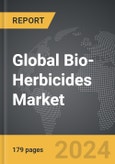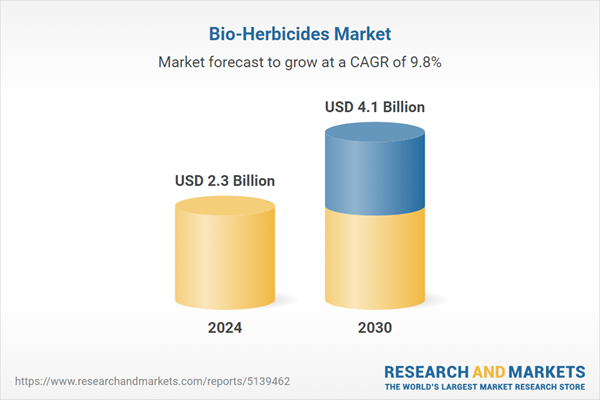The global market for Bio-Herbicides was valued at US$2.3 Billion in 2024 and is projected to reach US$4.1 Billion by 2030, growing at a CAGR of 9.8% from 2024 to 2030. This comprehensive report provides an in-depth analysis of market trends, drivers, and forecasts, helping you make informed business decisions.
Global Bio-Herbicides Market - Key Trends and Drivers Summarized
What Sets Bio-Herbicides Apart from Conventional Herbicides?
Bio-herbicides represent a significant shift in the approach to weed management, offering an environmentally friendly alternative to synthetic chemical herbicides. Unlike conventional herbicides that often rely on synthetic chemicals to control unwanted vegetation, bio-herbicides are derived from natural sources, such as plants, bacteria, fungi, and other microorganisms. These natural compounds work by exploiting specific vulnerabilities in weeds, such as disrupting their growth processes or outcompeting them for resources. This targeted approach reduces the risk of harm to non-target plants, animals, and soil health, which is a major concern with chemical herbicides that can lead to issues like soil degradation, water contamination, and the loss of biodiversity. Bio-herbicides also tend to break down more rapidly in the environment, minimizing their long-term impact and reducing the potential for chemical residues in food and water. As concerns about the environmental and health impacts of synthetic herbicides grow, bio-herbicides are gaining attention as a sustainable solution that aligns with the principles of integrated pest management (IPM) and organic farming.How Are Bio-Herbicides Being Developed and Utilized in Agriculture?
The development and application of bio-herbicides in agriculture have been steadily advancing, driven by ongoing research and innovation in the field of biopesticides. Scientists are exploring a wide range of natural compounds with herbicidal properties, including allelopathic chemicals produced by certain plants, phytotoxins from fungi, and herbicidal metabolites from bacteria. These discoveries are being harnessed to create bio-herbicides that can be used in various agricultural settings, from row crops to orchards and vineyards. In practice, bio-herbicides are often used in conjunction with other weed management strategies, such as crop rotation, mechanical weeding, and the use of cover crops, to enhance their effectiveness and sustainability. Some bio-herbicides are formulated as contact herbicides that kill weeds on contact, while others are systemic, meaning they are absorbed by the plant and disrupt its internal processes. The adoption of bio-herbicides is particularly strong in organic farming, where the use of synthetic chemicals is restricted, but they are also gaining ground in conventional agriculture as part of an integrated weed management approach. This dual adoption underscores the versatility and potential of bio-herbicides to address the diverse needs of modern agriculture while reducing reliance on chemical inputs.What Challenges and Opportunities Exist for Bio-Herbicides?
While bio-herbicides offer many advantages, their widespread adoption faces several challenges. One of the primary hurdles is their variable efficacy, which can be influenced by environmental factors such as temperature, humidity, and soil conditions. Unlike synthetic herbicides, which are often designed to perform consistently across a wide range of conditions, bio-herbicides may require more specific application timing and conditions to be effective. This variability can limit their use in large-scale commercial agriculture, where consistent weed control is critical. Another challenge is the development process itself, which can be more complex and costly compared to chemical herbicides. Identifying and isolating effective bioactive compounds, ensuring their stability, and scaling up production are all significant hurdles. Despite these challenges, there are also considerable opportunities for growth and innovation in the bio-herbicide market. Advances in biotechnology and genetic engineering are opening new avenues for the development of more effective and reliable bio-herbicides. Additionally, the increasing demand for organic and sustainably produced food is creating a strong market incentive for bio-herbicides, as consumers and regulators push for reduced chemical use in agriculture. As research and technology continue to advance, the potential for bio-herbicides to play a larger role in sustainable agriculture is becoming increasingly clear.What Is Fueling the Expansion of the Bio-Herbicides Market?
The growth in the bio-herbicides market is driven by several factors, including technological advancements, changing consumer preferences, and increasing regulatory pressures. Technological innovations are enabling the discovery and development of new bio-herbicidal compounds with improved efficacy and broader application potential. For instance, advances in microbial fermentation and plant biotechnology are facilitating the production of bio-herbicides on a commercial scale, making them more accessible and cost-competitive. Consumer demand for organic and non-GMO products is also fueling market growth, as these consumers prioritize natural and environmentally friendly inputs in food production. This shift in consumer behavior is encouraging farmers and agricultural companies to adopt bio-herbicides as part of their weed management strategies. Moreover, the tightening of regulations on chemical herbicides, particularly in regions like the European Union and parts of North America, is pushing the agricultural industry to seek alternatives that comply with stricter environmental and safety standards. Government incentives and subsidies for sustainable farming practices are further supporting the adoption of bio-herbicides, creating a favorable market environment. The convergence of these factors is driving robust growth in the bio-herbicides market.Report Scope
The report analyzes the Bio-Herbicides market, presented in terms of market value (US$ Thousand). The analysis covers the key segments and geographic regions outlined below.Segments
Application (Foliar, Soil Treatment, Soil Application, Other Applications).Geographic Regions/Countries
World; United States; Canada; Japan; China; Europe (France; Germany; Italy; United Kingdom; and Rest of Europe); Asia-Pacific; Rest of World.Key Insights:
- Market Growth: Understand the significant growth trajectory of the Foliar Application segment, which is expected to reach US$1.6 Billion by 2030 with a CAGR of a 11.0%. The Soil Treatment Application segment is also set to grow at 10.1% CAGR over the analysis period.
- Regional Analysis: Gain insights into the U.S. market, valued at $661.3 Million in 2024, and China, forecasted to grow at an impressive 9.0% CAGR to reach $613.4 Million by 2030. Discover growth trends in other key regions, including Japan, Canada, Germany, and the Asia-Pacific.
Report Features:
- Comprehensive Market Data: Independent analysis of annual sales and market forecasts in US$ Million from 2024 to 2030.
- In-Depth Regional Analysis: Detailed insights into key markets, including the U.S., China, Japan, Canada, Europe, Asia-Pacific, Latin America, Middle East, and Africa.
- Company Profiles: Coverage of major players such as Adria New Zealand Limited, American Vanguard Corporation, Bioherbicides Australia Pty Ltd., Bonsaishop Fagus, Chambal Fertiliser & Chemicals and more.
- Complimentary Updates: Receive free report updates for one year to keep you informed of the latest market developments.
Why You Should Buy This Report:
- Detailed Market Analysis: Access a thorough analysis of the Global Bio-Herbicides Market, covering all major geographic regions and market segments.
- Competitive Insights: Get an overview of the competitive landscape, including the market presence of major players across different geographies.
- Future Trends and Drivers: Understand the key trends and drivers shaping the future of the Global Bio-Herbicides Market.
- Actionable Insights: Benefit from actionable insights that can help you identify new revenue opportunities and make strategic business decisions.
Key Questions Answered:
- How is the Global Bio-Herbicides Market expected to evolve by 2030?
- What are the main drivers and restraints affecting the market?
- Which market segments will grow the most over the forecast period?
- How will market shares for different regions and segments change by 2030?
- Who are the leading players in the market, and what are their prospects?
Some of the 11 major companies featured in this Bio-Herbicides market report include:
- Adria New Zealand Limited
- American Vanguard Corporation
- Bioherbicides Australia Pty Ltd.
- Bonsaishop Fagus
- Chambal Fertiliser & Chemicals
- Chambal Fertilizers Chemicals Ltd.
- CroBio
- FMC Corporation
- Hindustan Bio-Tech Chemicals & Fertilizers Ltd.
- Ipag S.R.L.
Table of Contents
I. METHODOLOGYII. EXECUTIVE SUMMARY2. FOCUS ON SELECT PLAYERSIII. MARKET ANALYSISIV. COMPETITION
1. MARKET OVERVIEW
3. MARKET TRENDS & DRIVERS
4. GLOBAL MARKET PERSPECTIVE
UNITED STATES
CANADA
JAPAN
CHINA
EUROPE
FRANCE
GERMANY
ITALY
UNITED KINGDOM
REST OF EUROPE
ASIA-PACIFIC
REST OF WORLD
Companies Mentioned (Partial List)
A selection of companies mentioned in this report includes, but is not limited to:
- Adria New Zealand Limited
- American Vanguard Corporation
- Bioherbicides Australia Pty Ltd.
- Bonsaishop Fagus
- Chambal Fertiliser & Chemicals
- Chambal Fertilizers Chemicals Ltd.
- CroBio
- FMC Corporation
- Hindustan Bio-Tech Chemicals & Fertilizers Ltd.
- Ipag S.R.L.
Table Information
| Report Attribute | Details |
|---|---|
| No. of Pages | 179 |
| Published | March 2025 |
| Forecast Period | 2024 - 2030 |
| Estimated Market Value ( USD | $ 2.3 Billion |
| Forecasted Market Value ( USD | $ 4.1 Billion |
| Compound Annual Growth Rate | 9.8% |
| Regions Covered | Global |









